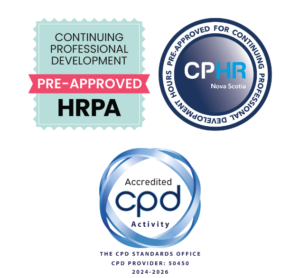Program Overview
In today’s complex work environment, it’s crucial for professionals to be prepared to support employees during times of crisis. Employees are not just resources; they are individuals with emotions and unique needs. Building a thriving workplace culture requires recognizing and addressing these needs. Our program equips professionals with the knowledge, skills, and tools needed to effectively navigate workplace crises, ultimately boosting employee well-being and enhancing organizational performance.
By the end of the Crisis Ready Workplace program, you will be able to:
- Mitigate Risks: Identify and address potential workplace crises proactively.
- Manage Crises with Confidence: Feel prepared and confident when handling crises as they arise.
- Develop a Growth Plan: Create a roadmap to continually enhance your skills and habits for managing workplace crises effectively.

Delivery Format
- Delivered over four weeks via webinar in three-hour sessions.
- Leveraging Zoom Webinar platform
- Learners will be put into break out rooms for activities.
- Lecture and interactive activities
- Learners will receive a manual that will include all PPT, Activities and Value add resources, as well a special appendix off tools to help the professional evolve and mature their ability to support employees experience stress or in crisis.
- All sessions will be recorded, allowing participants who miss a session due to scheduling conflicts to watch the video later.

Perks for Taking This Program
- Program is accredited by CPD International that demonstrates this training has meet an international standard in quality for adult learners. Learners will get a professional certificate of completion that can use for their portfolio and CEUs
- HR professionals can apply after successfully completing this program 12 hours towards HR CEU.
- Other professionals can apply to their professional organization for CEU such as OHS, Counsellors, Psychologists, Legal, and Accounting.
What is Covered in the Four Blocks
Oct. 7, 2025: Block 1 – Foundation (3 hours)
Module 1 – Introduction to crisis management
Identify key performance behaviours of trusted leaders and develop habits that make employees feel secure and valued.
Learning Objectives
• Explore crisis management within a workplace context
• Review of the six-step model for dealing with workplace crises
• Discuss micro-skills required to remain calm in a crisis
Module 2 – Facilitating a safe and respectful workplace
Understand legal obligations and strategies for creating a respectful workplace while supporting employees facing domestic violence.
Learning Objectives
• Explore the continuum for creating safe and respectful workplaces
• Discuss the micro-skills required to prevent misunderstandings, incivility and conflict from escalating
• Define the role of leaders in facilitating safe and respectful workplaces
Oct. 14, 2025: Block 2 – Responder (3 hours)
Module 3 – Facilitating a trauma-informed workplace
This module introduces what employers and leaders can do to facilitate a trauma-informed workplace and outlines their roles.
Learning Objectives
• Introduce a trauma-informed workplace and how it can be beneficial for preparing for crisis prevention
• Discuss actions to mitigate trauma triggers within the workplace
Setting up the day, questions from the last block
Module 4 – Early detection of employees at risk in the workplace
Recognize the signs of mental health risk and learn how to engage with employees effectively.
Learning Objectives
• Explore signs an employee is at risk of impairment or mental illness
• Review Duty to Inquire
• Examine a five-step model for facilitating Duty to Inquire
Oct. 21, 2025: Block 3 – Prevention (3 hours)
Module 5 – How to manage an angry person
Equip yourself with strategies to handle confrontations with angry employees while maintaining a safe environment.
Learning Objectives
• Understand the cycle of anger and how to anticipate it
• Examine how and when it is best to interact with someone angry in the workplace
• Review common mistakes made when dealing with an angry person
Module 6 – How to support a suicidal employee
Receive guidance on addressing suicidal ideation and understanding the critical steps for supporting at-risk individuals.
This module guides HR leaders on what to do if confronted with an employee implying they are contemplating death by suicide.
Learning Objectives
• Review common myths about suicide
• Understand the relationship between suicide ideation, utopia decision and death by suicide
• Explore a suicide prevention model for supporting a person at risk by reaching out to mental health support (e.g., 9-8-8).
Oct. 28, 2025: Block 4 – Micro interventions (3 hours)
This building block will consist of micro interventions, with each topic covered in approximately 20 minutes, followed by a space for Q&A. The sessions aim to enhance your understanding of how to create a crisis-ready workplace readiness can reduce mental harm during challenging situations.
- Tackling Domestic/Intimate Partner Violence in the Workplace
Exploring how to prepare and support employees in crisis due to domestic/inmate violence that shows up in workplace. - Support Teams After Colleagues’ Death by Suicide
Reviewing how to support teams cope after the loss of peer due to death by suicide. - Addressing Armed Assailant Risks
Discuss proactive measures to mitigate the risks associated with armed assailants in the workplace. - Financial Crisis Fallout
Explore the impact of financial crises on employee productivity and learn to create a supportive work environment. - Improving Toxic Workplaces
Identify toxic elements within the workplace and develop strategies for fostering a healthier organizational culture. - Dealing with Verbal Abuse
Address verbal misconduct and its effects on employees while promoting a respectful and safe workplace culture.
Learning Objectives:
- Learn the knowledge and skills needed to handle various crisis situations.
- Grow your toolkit for managing different types of workplace crises.
- Gain strategies to reduce mental harm during each crisis situation.

